There are many different ways to notate music, whether that be with the Roman numeral system, traditional notation or what we will talk about in this post, the figured bass notation system. Although figured bass is not used anymore it is an important aspect of music theory to learn.
What is figured bass?
Figured bass is a notation system used mostly during the baroque era of classical music, the 17th and 18th centuries.
This type of notation is categorised by writing numbers below the bass notes. The numbers then represent what chord should be played above the bass note.
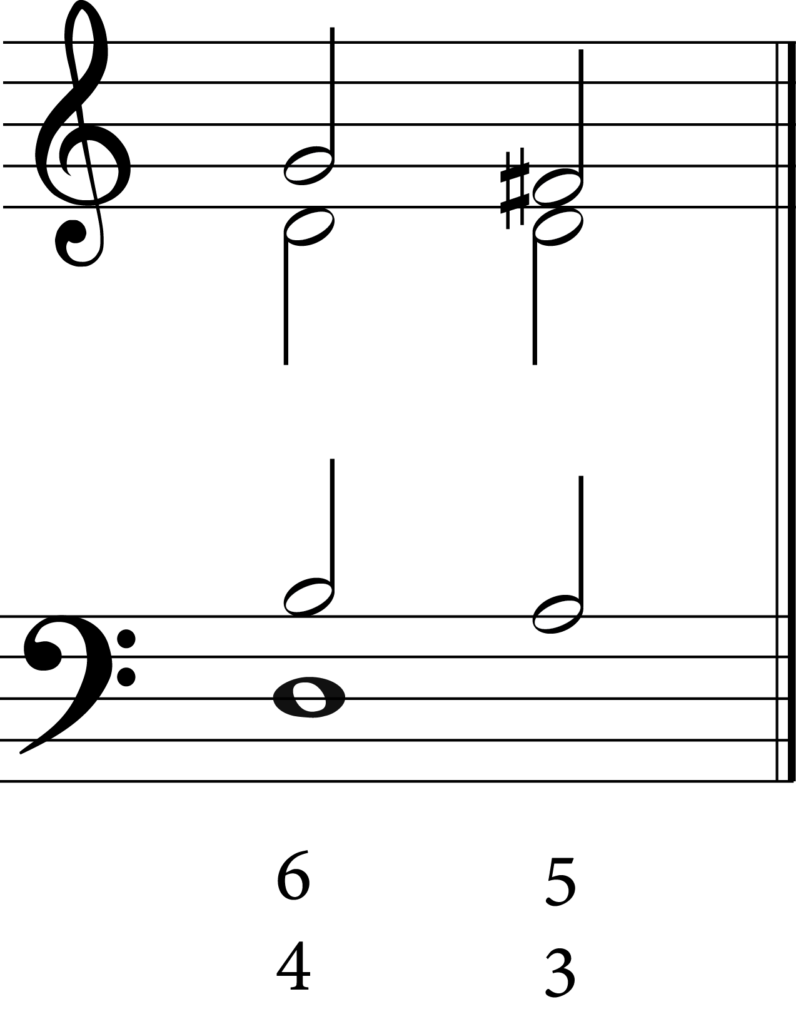
During the baroque period, composers would only ever write out a bass line and a melody. They would not write out the inner parts, leaving the performer to decide how to fill the chord voicing. The figured bass symbols made it easier for the performer to do this, this was called figured bass realization.
Usually, a soloist or soprano voice would sing the melody line and a keyboard instrument such as the harpsichord would play the figured bass line. This keyboard player would be expected to improvise using the figured bass provided.
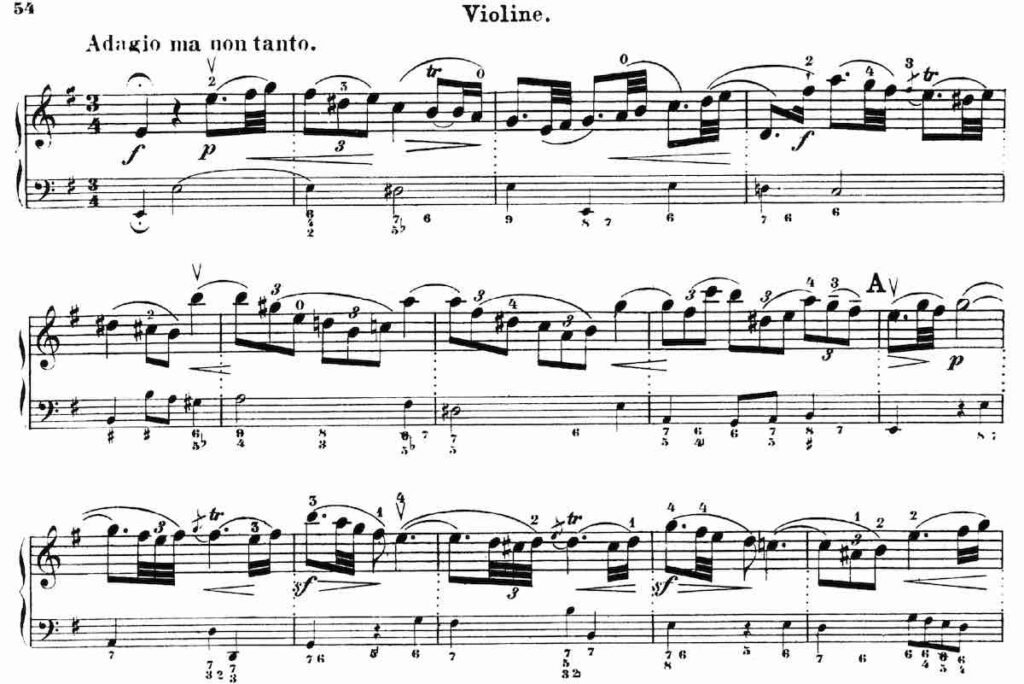
How to read and write with figured bass
In order to be confident with reading and writing with figured bass notation it is important to understand what the different numbers mean. The figured bass numbers will be written below a notated bass line.
Figured bass numbers vary as to whether you are writing triads or seventh chords.
The numbers themselves simply indicate the interval above the given bass note. The key signature will then also help to determine whether the chord will be a major triad or a minor triad. It is also possible to include chromatic alteration on each chord and this can alter the quality of the chord further, but more on this later.
Root position chords
A triad is a chord that consists of three notes. A triad is formed by the root of the chord, the third above the bass and the fifth above the bass note.
Below you can see a triad built above the root note ‘C’. Notice how we have a C in the bass and the upper voices are indicated by the figured bass.

In order to use figured bass to represent the above C triad, you can simply have the bass note C written and then the number 5/3 written underneath. The 3 represents the third above the bass note and the 5 represents the fifth above the bass note.
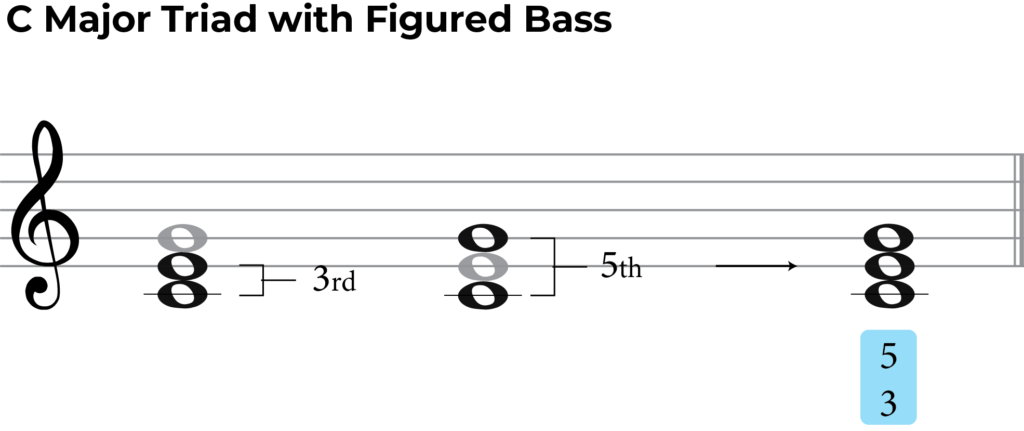
What we have seen above is a root position c major triad. You can write the number 5/3 under any bass note and this will indicate that the performer should play a root position triad above that particular note. The note in the bass is the chord’s
All the chords below are root position chords.

However, not all chords are in root position. It is possible to have inversions. As a triad only has three notes, there are only three different ways the chord can be written. Root position, first inversion and second inversion.
First inversion chords
In order to indicate that a chord is in first inversion you must use slightly different numbers.
The figured bass for the first inversion triad is 6/3, indicating that you want a third above the bass note and a sixth above the bass note. Below you can see a first inversion chord in c major.
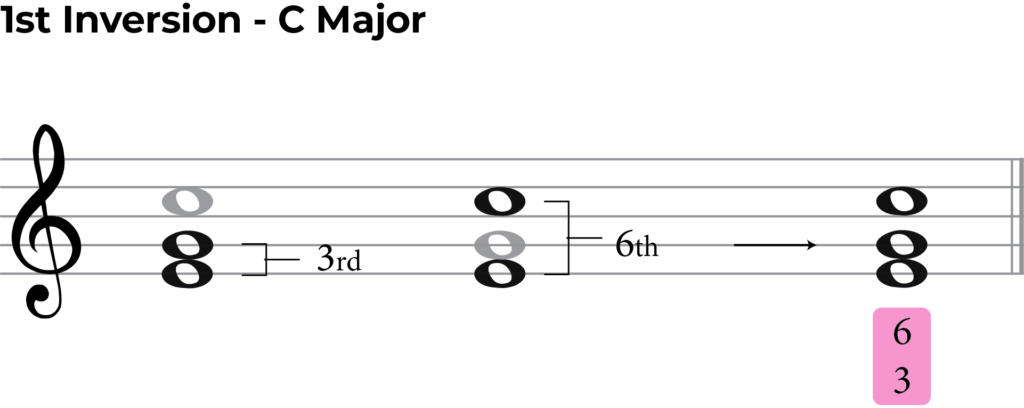
In practice, you do not always write 6/3, usually the notation will simply just be the number 6.
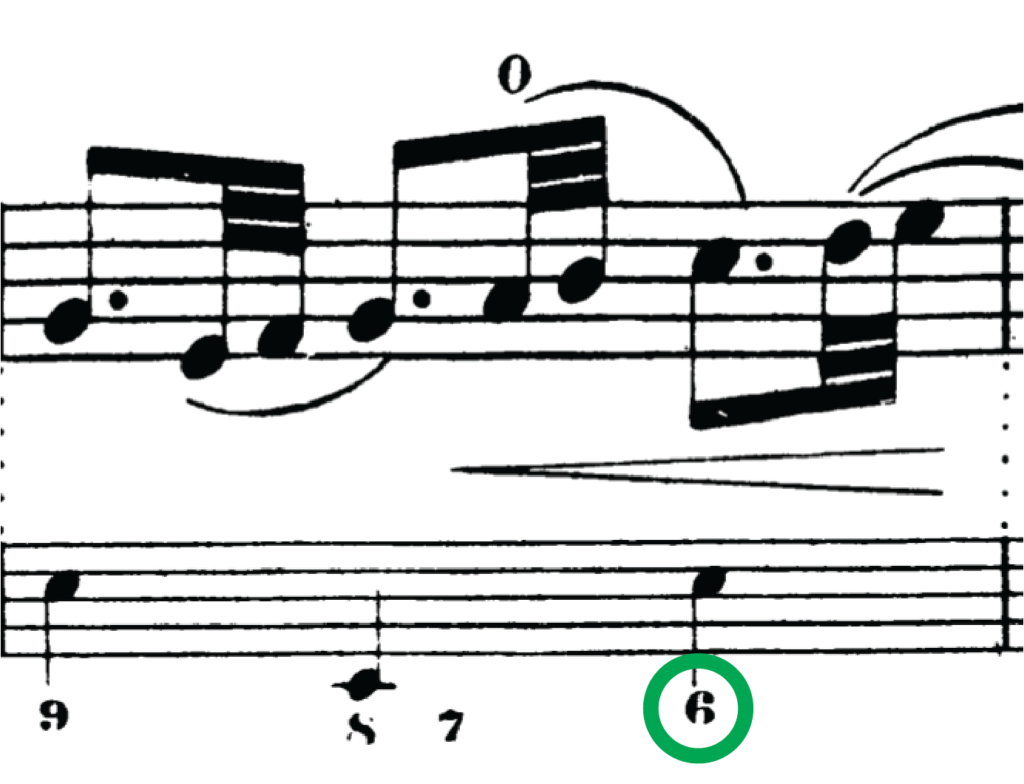
All the chords below are first inversion chords.

Second inversion chords
In order to indicate that a chord is a second inversion chord then you will need different numbers again.
The figured bass numbers for a second inversion chord are 6/4, literally indicating that you need to play a fourth above the bass note and a sixth above the bass note.
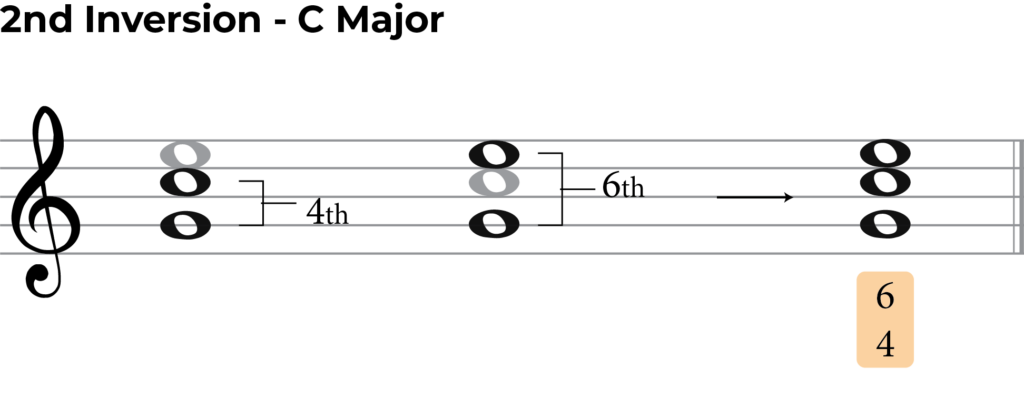
All the chords below are second inversion triads.

Ear Training and Chords
To develop as a musician you’ll want to be able to recognise chords by ear. This is where ear training comes in. My recommendation for this is Tonegym as they have a comprehensive and fun program for training your ears! It’s what has gotten the best results with for my own students.
In the ‘tools’ section of their site, Tonegym even have a chord player that allows you to listen virtually any chord.
For an in-depth look at ear training, here’s my full review of Tonegym.

Figured bass realization
As you have seen above, the figured bass numbers indicate the interval above the bass notes provided. However, it is important to note, that these intervals don’t just have to be simple intervals. They can also be Compound intervals. Below you can see an example of an F major chord. The first example uses simple intervals and the second example uses compound intervals.

Doubling notes
When realizing figured bass, it is important to note that there is no indication which notes should be doubled. Particularly in choral music, where we have four chord voicing (SATB), the soprano voice, the alto voice, the tenor voice and the bass voice, it is important that one of the notes is doubled. Remember a triad only consists of three notes.
The best note to double is the root of the chord.
In this Bach chorale you can see the F major chord has a low F in the bass clef and another F above middle C.
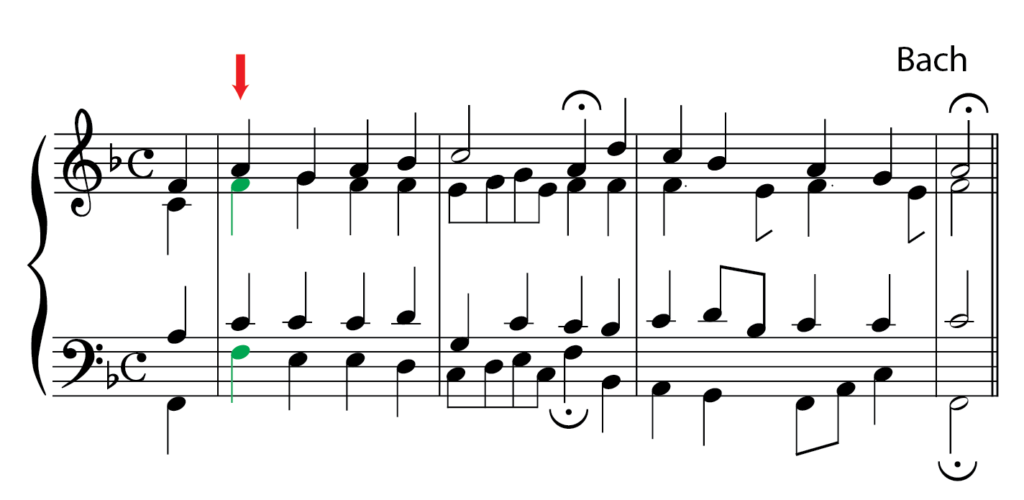
Chromatic Alteration
Figured bass can sometimes include sharps or flats. The accidental (sharp or flat) will be written next to the figure that it affects.
If you have an accidental on its own, not next to a figure, this is because your chord is in root position. Remember a lack of figures means 5/3 which is a root position chord. A single accidental on its own with no figures means that the third of the chord will be sharpened.
For example take a look at the chord below. We have a G in the bass note.

This indicates that we want the B, a third above the G, to be sharpened, becoming B#. The note above this will simply just be a fifth above, D.

This is more obvious in other figurings. Take the second inversion triad, 6/4. If we want to indicate one of the notes need an accidental we simply write it next to the relevant number.

In the above example you can see a C# as the bass note. The figured bass indicates a second inversion chord, 6/4, with the sixth above the bass note to be sharpened.
Chromatic alteration is most often seen in minor keys, this is due to the harmonic and melodic versions of the scales. The dominant chord will usually be a major chord and therefore will have a raised third. For example, in A minor, chord V will need a G#

What do the lines mean?
If you see lines drawn after the figured bass notation, this indicates that you should continue the same chord!

Seventh Chords and Figured Bass
Seventh chords present a different set of figured bass notations that we need to remember.
Root Position Seventh Chords
A seventh chord is a chord that consists of four notes. A seventh chord is formed by the root of the chord, the third above the bass, the fifth above the bass note and the seventh above the bass note.
Below you can see a seventh chord built above the root note ‘C’. Notice how we have a C in the bass and the upper voices are indicated by the figured bass.

In order to use figured bass to represent the C triad, you can simply have the bass note C written and then the numbers 7/5/3 written underneath. The 3 represents the third above the bass note, the 5 represents the fifth above the bass note and the 7 represents the seventh above the bass note.

What we have seen above is a root position c major seventh chord. You can write the numbers 7/5/3 under any bass note and this will indicate that the performer should play a root position seventh chord above that particular note. Note that we don’t always have to write the figured 5/3, often you will see a root position seventh chord simply indicated with just the number 7.
All the chords below are root seventh chords.

However, not all seventh chords are in root position. It is possible to have inversions. As a seventh chord has four notes, there are four different ways the chord can be written. Root position, first inversion, second inversion and third inversion.
First inversion seventh chords
In order to indicate that a seventh chord is in first inversion you must use slightly different numbers.
The figured bass for the first inversion triad is 6/5/3, indicating that you want a third above the bass note, a fifth above the bass note and a sixth above the bass note. Below you can see a first inversion c major seventh chord.

In practice, you do not always write 6/5/3, usually the notation will simply just be the number 6/5.
All the chords below are first inversion seventh chords.

Second inversion seventh chords
In order to indicate that a chord is a second inversion seventh chord then you will need different numbers again.
The figured bass numbers for a second inversion seventh chord are 6/4/3, literally indicating that you need to play a third above the bass note, a fourth above the bass note and a sixth above the bass note.

In practice, you do not always write 6/4/3, usually the notation will simply just be the numbers 4/3.
All the chords below are second inversion seventh chords.

Third inversion seventh chords
In order to indicate that a chord is a third inversion chord then you will need different numbers again.
The figured bass numbers for a third inversion seventh chord are 6/4/2, literally indicating that you need to play a second above the bass note, a fourth above the bass note and a sixth above the bass note.

In practice, you do not always write 6/4/2, usually the notation will simply just be the numbers 4/2.
All the chords below are third inversion triads.

Combining figured bass with Roman numerals
Figured bass is used to indicate the inversion of the chord you would like to play. It does not indicate which chord to play in relation to the key. In order to do this, you must look at the bass note.
Roman numerals are a little different as they indicate which chord to play.
But what happens if you combine the two? Combining both the figured bass and Roman numerals can provide an excellent way of reading music.
Roman numerals indicate the root of the desired chord and the figured bass will indicate the inversion. Take a look at the example below.
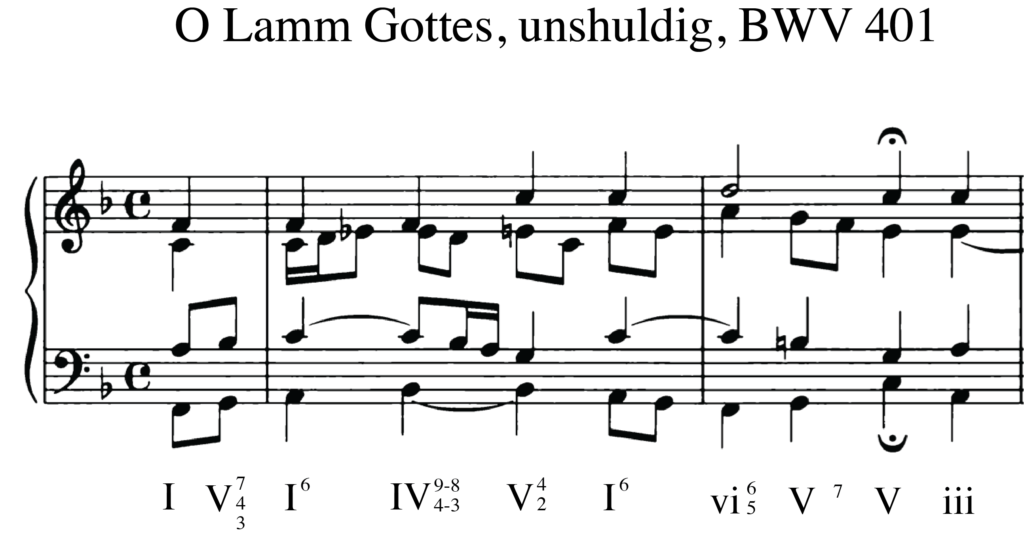
Notice how the first chord simply has a I, this indicates that you are to play the tonic chord of F major in root position. Moving to the next chord notice how we have chord V, indicating to play the dominant chord of F major but then we also have the figured bass 7/4/3. This is telling us to play the dominant seventh chord in second inversion.
You can also use figured bass to indicate melodic motion above the bass line. We can indicate things like a 4-3 suspension, 7-6 suspension or a 9-8 suspension.
See if you can spot one of these in the example below:
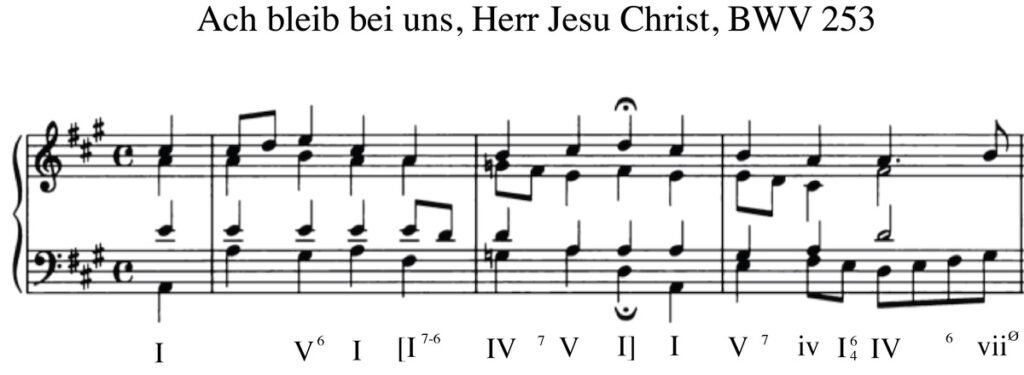
What next….?
- Learn about Roman numeral chord notation
- For a overview of different types of chords, see our complete guide.
